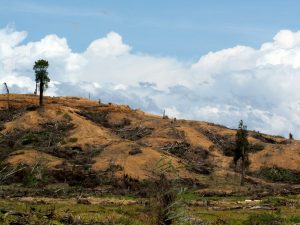Proper Gander
Palmed Off

One of capitalism’s booming industries over the last few decades has been palm oil production. In the early 1960s, less than a million tonnes were being processed each year, compared with well over sixty million yearly more recently. The negative impact this has on the environment is now being reported more widely, and BBC3 has joined in the debate with a short-but-sweet documentary focusing on palm oil’s use in the cosmetics trade.
Unmasked: Make-Up’s Big Secret is presented by Emmy Burbidge, who runs her own beauty salon in Somerset. She says that more of her clients are asking about the make-up of the make-up she uses, especially whether it contains palm oil. Finding this out can be tricky, as it’s often hidden under less-than-glamorous names like ‘sodium kernalate’ and ‘octyl palmitate’. But as palm oil is used in 70 percent of cosmetics, especially oilier products such as lipsticks and foundations, there’s a reasonable chance that your slap contains extracts from palm trees grown thousands of miles away.
The oil comes from the fruit which grows in bunches on the trees’ branches. The flesh in the kernel is used for cosmetics, being more saturated than the rest of the fruit, whose oil is used as an ingredient in many foods. Being solid at room temperature, it’s useful for making in-front-of-the-telly grub such as biscuits, instant noodles and peanut butter. It’s also used in biofuels, which are gaining traction as an alternative to relying on ever-dwindling fossil fuels. In 2018, half of all the palm oil in Europe was used to fuel cars and lorries (Reuters, 14 June 2018). Unfortunately, though, palm oil-based biodiesel generates three times as much carbon emissions as fossil fuels (dw.com, 22 June 2018), so it’s less environmentally friendly than we might assume.
The main reason that palm oil has been cited as bad for the environment, however, is that to make room for its plantations, millions of hectares of rainforest have been bulldozed. In the jungles of Indonesia, Malaysia and Nigeria, complex, lively ecosystems have been destroyed, with the added disadvantage of losing plants which soak up carbon from the atmosphere (including that which comes from palm oil-based biofuel). The programme shows sad footage of an orangutan trying to hit back at a bulldozer driving through churned up soil and tree stumps.For the documentary, Burbidge flies to Papua New Guinea, home to the world’s third largest rainforest, and sees through the plane window what some of this forest has been turned into by palm oil producers.
She visits an indigenous community who leased their land to a large developer company after being promised money and improved homes and schooling, most of which hasn’t materialised. Maybe one reason why the school was never built is that it would pull children away from being used as labourers in palm harvesting. Many of the people she meets are upset and even ashamed that they’ve had to sacrifice some of the forest they live in for not enough money to manage. Some producers aim for more sustainable methods by avoiding ploughing up more rainforestsand treating their workers less harshly than the more unscrupulous companies. The workers Burbidge meets don’t know what happens to the palm fruits once they leave the plantation for processing or what theiroil is used for, so sheintroduces them to lip gloss. It’s not clear whether they think that the shiny pink goo is worth their long hours and the loss of the rainforests.
It does feel worth it, though, to the corporations behind palm oil production. The industry has become such a profit-magnet not just through exploiting workers and the environment, but because palm oil has several advantages over similar products. As well as its versatility, the palms used have a much higher yield than other oil crops. To produce one tonne of oil from sunflowers or coconuts uses up to ten times as much land than is needed to produce the same amount of palm oil. This efficiency means that it can be produced at lower costs, leaving more money to end up in the company owners’ coffers. The profitability of palm oil production is the reason behind its growth in the market, with environmental damage being a consequence which has only recently become controversial, or even noticed. But what is to be done?
Boycotting products made from less environmentally-friendly palm oil would only have a limited effect, even assuming people would know which products to avoid. As Burbidge discovered, finding palm oil’s pseudonyms on an ingredients list isn’t always straightforward, and there’s no widely accepted certification for more sustainably-produced palm oil, unlike for ‘Fairtrade’ products, for example. And how many people worldwide would bother, or even be in a position to pick-and-choose? Even if a mass boycott dented the profits of the dodgier production firms, it wouldn’t remove the profit motive which leads companies to find the most cost-effective methods, regardless of the harm to the environment. Nor would it prevent the workers harvesting palm oil from being exploited both through their labour and selling off their landwhether or not they want to get dragged further into the capitalist economy.The downsides with how palm oil is produced are symptoms of wider problems with the system itself, and so it must be the system which is changed.
MIKE FOSTER
